|
|
|
|
Products mentioned in this Article
|
|
|
|
|
|
|
|
|
 |
|
|
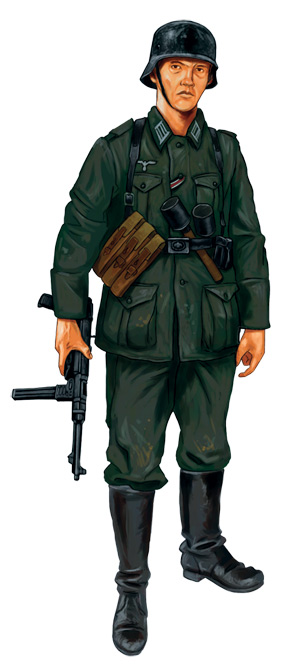 |
Evan’s German Army Painting Guide
Infantry 1939-43
The German Armed Forces, or Wehrmacht, went to war in 1939 in Poland and set the world alight for 6 long years. During that time they kept the same basic uniform and equipment but added or improved upon some items that are still used today. This painting guide is the first in a series I plan to write to try and help make the seemingly complex task of getting those German armies painted for Flames of War gaming a little easier. As the title says I’m going to concentrate here on just the standard uniform and equipment used by the Army from the invasion of Poland to the end of 1943. Future articles will cover specialist uniforms like the PanzerTruppen and camouflage items etc.
The colours I’ve chosen to use are my personal preferences so please don’t treat them as “gospel” I’ve used Vallejo paints exclusively for the figures shown below so if you want colour matches from other paint ranges you’ll need to visit the FoW comparison chart. I’ve used the dating system for describing uniform items as used by re-enactors such as “M1940” & “M1942” to help you get an idea of the timelines for the introduction of new or improved uniforms but don’t get hung up on them as they are a guide only!
The German Army, or Heer, adopted the Fieldgrey uniform in 1935 but the name is misleading as it’s anything but grey – green with a greyish tinge might be the best description.
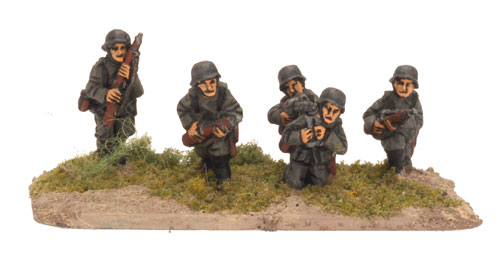
|
As the war progressed and Germanys situation deteriorated the cloth
used for new uniforms lost its quality and the colour began to vary,
sometimes by a considerable margin.
|
|
Most model colours are formulated to suit 1/35 scale models so you really need to lighten them down for large areas like uniforms and as an example these first miniatures (right) have been done firstly in German field Grey WWII VP830 and the second figure has had a highlight applied of the same colour mixed with 15-20% white no.951.
This next figure I’ve painted the equipment but not the actual soldier (which I’ve cunningly concealed in grey) to better show you what I’m talking about. Starting at the top:
|
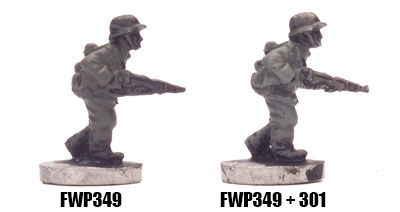 |
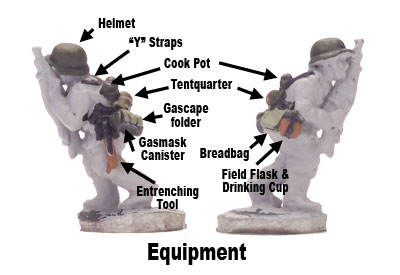 |
Helmet - base of Panzer Grey (FWP303) with a dry brush of Heer Green (FWP340)
“Y” straps, Belt (Koppel) & Cartridge pouches (Patronentasche) – Black (FWP300)
Cook pot (Kochgeshirr) - Same as for the Helmet but I’ve also skimmed over the edges with Dark Gunmetal (FWP480) to show exposed metal edges from use.
Tentquarter (Zeltbahn) – base ofTan Leather (FWP384) and camouflage pattern of Army Green (FWP342) + Battlefield Brown (FWP324)
Breadbag (Brotbeutal) - Tommy Green (FWP345)
|
|
Gasmask Canister (Tragbüchse für Gasmaske) – same as for the cook pot
GasCape folder (fastened on top of gasmask canister) - Tommy Green (FWP345)
Field flask & Drinking cup ((Feldflasche und Trinkbecker) - main body Battlefield brown (FWP324) and the cup same as for the gasmask canister & cook pot
Entrenching tool (kleines Schanzzeug) – carrier & Bayonet scabbard Black (FWP300), wooden spade handle Battlefield brown (FWP324)
These colours are representative of what was in
common usage by the German Wehrmacht, but they did use variations and
also equipment captured from occupied countries as well to supplement
their own.
|
This soldier’s (right) uniform is as you’d see it during the invasion of Poland and then France in 1940.
He’s wearing the first pattern M1935 field grey uniform jacket with Stone grey trousers.
|
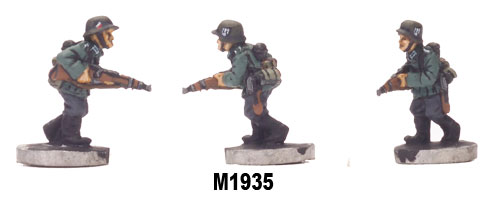 |
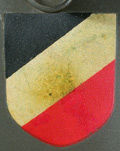 |
The helmet has both the national shield on the right side (left) and the eagle on the left side (below right). His shoulder straps and collar are dark green with white edging on the shoulder straps, which denotes him as an Infantryman or “Landser” (the German equivalent of “Tommy” or “GI”). Troops wearing this uniform could still be found at the start of “Barbarossa” the invasion of the Soviet Union although the national shield was removed after the occupation of France was complete. The uniform colours I’ve used are:
Jacket (to show better quality cloth)
|
GI Green (FWP347)
|
Trousers
|
Dark Gunmetal (FWP480)
|
Collar & Shoulder straps
|
Heer Green (FWP340)
|
|
|
A method of adding the white edging to the shoulder straps that I use is to paint the white on first then add the dark green over the top.
This next figure (below) is wearing the reed green uniform that was
used as a hot weather expedient in summer, especially in the south of
Russia from 1942 onwards.
This is the fatigue uniform that was
originally off-white but then changed to olive green so it could be
used in the field.
|
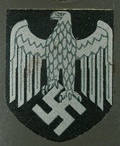 |
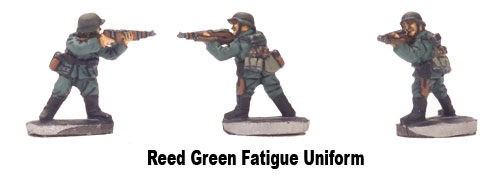 |
The only reason it appears here is because the same colour as the previous uniform seemed, to me, the most suitable match, GI Green (FWP347), for both jacket and trousers and highlighting as well.
|
In 1940 a new version of the uniform tunic appeared. It was the same as the previous one except the collar and shoulder straps were now the same field grey. These jackets took a while to filter down to the existing troops but newly raised formations would all be wearing them so you can use either version for your troops. The material used for the jackets is starting to lose its quality and I would recommend using Grenadier Green (FWP349) for the uniform jacket and trousers for the rest of the midwar period.
|
|
This figure (right) is wearing the new jacket with the Fieldgrey collar and shoulder straps but also the “retreat gaiters” first issued in Feb. 1941 to go with the black leather ankle boots that were introduced to save on leather.
These anklets and boots were relatively uncommon until 1943 but then became pretty much the standard for all but those lucky troops who hadn’t worn out their original marching boots.
|
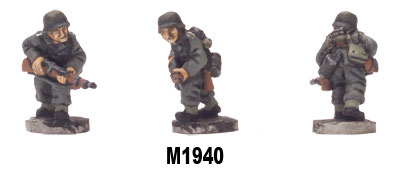 |
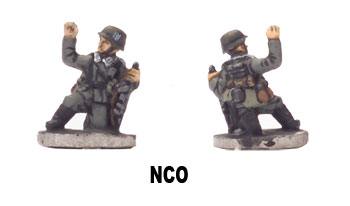 |
NCOs (left) were distinguished by bands of lace around the front and edge of the collar and also the shoulder straps. These were initially in bright aluminium but I personally think white is a better colour to depict this.
After 1940 the braid was changed to a mouse grey colour which, in this scale, is virtually indistinguishable so you could either just ignore it altogether or keep using white/aluminium as the earlier type of braid.
Officers were issued uniforms made of better quality cloth than other ranks but they were still the same colour. At platoon commander level they were supposed to wear the same uniform and equipment as the normal soldier but more usually they kept items like riding breeches and large cuff turnbacks on the jackets.
|
|
This officer I’ve painted is wearing a pistol holster and map case on a black leather belt, Officers belts were officially brown but black was usually worn, in the field, by platoon officers. Officer rank was displayed on the shoulder straps with aluminium braid.
For this officer (right) I’ve used:
Jacket
|
Grenadier Green (FWP349)
|
Trousers
|
Dark Gunmetal (FWP480)
|
| Pistol holster & Map Case |
Dark Leather (FWP322)
|
Officers Shoulder Straps
|
Cold Steel (FWP481)
|
|
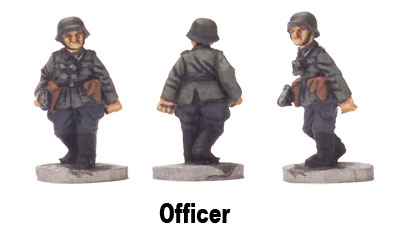 |
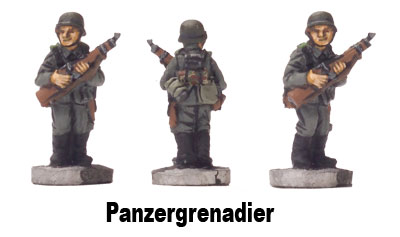 |
The only difference for this German soldier (left) is his shoulder straps. They have a border of “GrassGreen” the Waffenfarbe (Arm of Service colour) of the infantry component of the Schnelle Truppen. These were the Schützen or motorized troops in the Panzer divisions and, after July 1942, renamed Panzergrenadiers.
I used the same technique as for the infantryman above to achieve the edging around the shoulder straps. The Grassgreen (Jager Green (FWP344)) was painted on first then the field grey uniform colour was painted over the top.
|
|
This miniature could also be from a Jäger battalion or Light Infantry Division as they had a very similar Waffenfarbe of “Lightgreen” – the marching boots wouldn’t work too well with a Gebirgsjäger unit though.
|
|
The MG teams armed with the MG-34 squad automatic weapon had a few pieces of specialized equipment.
The no.1 gunner carried a pistol holster and specialist leather toolbox on his belt instead of the usual ammunition pouches and these were usually made from black leather.
|
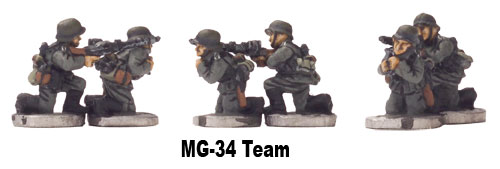 |
|
The no.2 gunner had the normal ammunition pouches and usually carried the spare barrels box, a long metal container painted Fieldgrey and slung over the shoulder. Otherwise they have the same uniform and equipment as any other German Landser.
Here is a selection of the more common Waffenfarbe (Arm of Service colour) It’s not an exhaustive list but it covers the most commonly used colours. The Waffen SS used the same colour system, but used white instead for their PanzerGrenadiers
White – Infantry and Gross Deutschland Division infantry (even when a Panzer division)
Pink – Panzer troops, Anti tank troops (including Panzerjäger battalions and corps level anti tank battalions) and Armoured Recce troops. An exception to this is the panzer regiment of 24 Panzer div.
GrassGreen - Motorized troops of Panzer divisions and also when renamed Panzer grenadier.
Light Green – Jäger battalions, Light Infantry divisions and Gebirgsjager divisions.
Red – Artillery troops both towed and self-propelled, some Stug battalions and all Rocket
Artillery troops
Golden Yellow – 24th Panzer division Panzer regiment, Cavalry, Divisional Recce and Motorized Recce battalions
Black – Pioneer/Engineer battalions
And finally, the figures in the late war pack (GE722) are just as suitable for the midwar period even with the MG42 mgs.
|
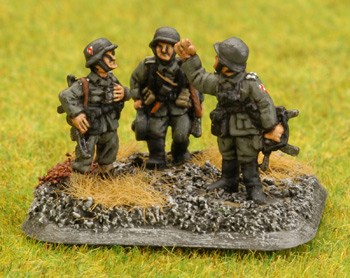 |
The MG42 started to appear in mid 1942 and the only other differences are the inclusion of a scattering of camouflage smocks and helmet covers, which had started to appear in Heer units as well, and they’re wearing the M1942 uniform. The M1942 uniform was the same colour and cut as the previous version but was of simplified construction to ease supply. An important point to note here is they were issued as needed and didn’t replace any previous uniform – you can mix figures from both Early/Mid & Late War blisters to your hearts content. The next installment in this series will include Panzer crew uniforms and Heer Camouflage amongst other things.
Have fun painting!
Evan
Left: Here Wayne has used a mix of GE701/2 and GE721/2 miniatures for his Croatians.
|
Last Updated On Tuesday, June 30, 2015
|
|
|